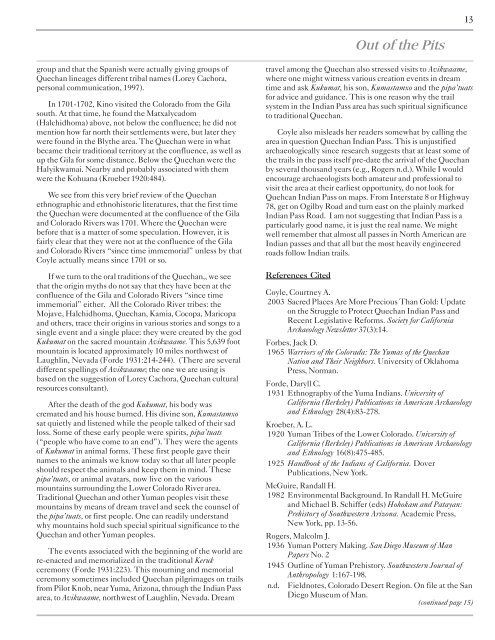March 2004 - Society for California Archaeology
March 2004 - Society for California Archaeology
March 2004 - Society for California Archaeology
Create successful ePaper yourself
Turn your PDF publications into a flip-book with our unique Google optimized e-Paper software.
13<br />
Out of the Pits<br />
group and that the Spanish were actually giving groups of<br />
Quechan lineages different tribal names (Lorey Cachora,<br />
personal communication, 1997).<br />
In 1701-1702, Kino visited the Colorado from the Gila<br />
south. At that time, he found the Matxalycadom<br />
(Halchidhoma) above, not below the confluence; he did not<br />
mention how far north their settlements were, but later they<br />
were found in the Blythe area. The Quechan were in what<br />
became their traditional territory at the confluence, as well as<br />
up the Gila <strong>for</strong> some distance. Below the Quechan were the<br />
Halyikwamai. Nearby and probably associated with them<br />
were the Kohuana (Kroeber 1920:484).<br />
We see from this very brief review of the Quechan<br />
ethnographic and ethnohistoric literatures, that the first time<br />
the Quechan were documented at the confluence of the Gila<br />
and Colorado Rivers was 1701. Where the Quechan were<br />
be<strong>for</strong>e that is a matter of some speculation. However, it is<br />
fairly clear that they were not at the confluence of the Gila<br />
and Colorado Rivers “since time immemorial” unless by that<br />
Coyle actually means since 1701 or so.<br />
If we turn to the oral traditions of the Quechan,, we see<br />
that the origin myths do not say that they have been at the<br />
confluence of the Gila and Colorado Rivers “since time<br />
immemorial” either. All the Colorado River tribes: the<br />
Mojave, Halchidhoma, Quechan, Kamia, Cocopa, Maricopa<br />
and others, trace their origins in various stories and songs to a<br />
single event and a single place: they were created by the god<br />
Kukumat on the sacred mountain Avikwaame. This 5,639 foot<br />
mountain is located approximately 10 miles northwest of<br />
Laughlin, Nevada (Forde 1931:214-244). (There are several<br />
different spellings of Avikwaame; the one we are using is<br />
based on the suggestion of Lorey Cachora, Quechan cultural<br />
resources consultant).<br />
After the death of the god Kukumat, his body was<br />
cremated and his house burned. His divine son, Kumastamxo<br />
sat quietly and listened while the people talked of their sad<br />
loss. Some of these early people were spirits, pipa’tuats<br />
(“people who have come to an end”). They were the agents<br />
of Kukumat in animal <strong>for</strong>ms. These first people gave their<br />
names to the animals we know today so that all later people<br />
should respect the animals and keep them in mind. These<br />
pipa’tuats, or animal avatars, now live on the various<br />
mountains surrounding the Lower Colorado River area.<br />
Traditional Quechan and other Yuman peoples visit these<br />
mountains by means of dream travel and seek the counsel of<br />
the pipa’tuats, or first people. One can readily understand<br />
why mountains hold such special spiritual significance to the<br />
Quechan and other Yuman peoples.<br />
The events associated with the beginning of the world are<br />
re-enacted and memorialized in the traditional Keruk<br />
ceremony (Forde 1931:223). This mourning and memorial<br />
ceremony sometimes included Quechan pilgrimages on trails<br />
from Pilot Knob, near Yuma, Arizona, through the Indian Pass<br />
area, to Avikwaame, northwest of Laughlin, Nevada. Dream<br />
travel among the Quechan also stressed visits to Avikwaame,<br />
where one might witness various creation events in dream<br />
time and ask Kukumat, his son, Kumastamxo and the pipa’tuats<br />
<strong>for</strong> advice and guidance. This is one reason why the trail<br />
system in the Indian Pass area has such spiritual significance<br />
to traditional Quechan.<br />
Coyle also misleads her readers somewhat by calling the<br />
area in question Quechan Indian Pass. This is unjustified<br />
archaeologically since research suggests that at least some of<br />
the trails in the pass itself pre-date the arrival of the Quechan<br />
by several thousand years (e.g., Rogers n.d.). While I would<br />
encourage archaeologists both amateur and professional to<br />
visit the area at their earliest opportunity, do not look <strong>for</strong><br />
Quehcan Indian Pass on maps. From Interstate 8 or Highway<br />
78, get on Ogilby Road and turn east on the plainly marked<br />
Indian Pass Road. I am not suggesting that Indian Pass is a<br />
particularly good name, it is just the real name. We might<br />
well remember that almost all passes in North American are<br />
Indian passes and that all but the most heavily engineered<br />
roads follow Indian trails.<br />
References Cited<br />
Coyle, Courtney A.<br />
2003 Sacred Places Are More Precious Than Gold: Update<br />
on the Struggle to Protect Quechan Indian Pass and<br />
Recent Legislative Re<strong>for</strong>ms. <strong>Society</strong> <strong>for</strong> Cali<strong>for</strong>nia<br />
<strong>Archaeology</strong> Newsletter 37(3):14.<br />
Forbes, Jack D.<br />
1965 Warriors of the Colorada: The Yumas of the Quechan<br />
Nation and Their Neighbors. University of Oklahoma<br />
Press, Norman.<br />
Forde, Daryll C.<br />
1931 Ethnography of the Yuma Indians. University of<br />
Cali<strong>for</strong>nia (Berkeley) Publications in American <strong>Archaeology</strong><br />
and Ethnology 28(4):83-278.<br />
Kroeber, A. L.<br />
1920 Yuman Tribes of the Lower Colorado. University of<br />
Cali<strong>for</strong>nia (Berkeley) Publications in American <strong>Archaeology</strong><br />
and Ethnology 16(8):475-485.<br />
1925 Handbook of the Indians of Cali<strong>for</strong>nia. Dover<br />
Publications, New York.<br />
McGuire, Randall H.<br />
1982 Environmental Background. In Randall H. McGuire<br />
and Michael B. Schiffer (eds) Hohokam and Patayan:<br />
Prehistory of Southwestern Arizona. Academic Press,<br />
New York, pp. 13-56.<br />
Rogers, Malcolm J.<br />
1936 Yuman Pottery Making. San Diego Museum of Man<br />
Papers No. 2<br />
1945 Outline of Yuman Prehistory. Southwestern Journal of<br />
Anthropology 1:167-198.<br />
n.d. Fieldnotes, Colorado Desert Region. On file at the San<br />
Diego Museum of Man.<br />
(continued page 15)

















